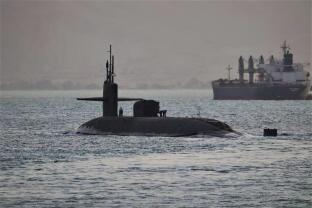In a rare move, Secretary of Defense Lloyd Austin told the world where a U.S. submarine was positioned in the Middle East. It was an unusual — and intentional — decision, a Pentagon official tells NOTUS.
“Secretary Austin obviously wanted to send a message by making this announcement,” the Pentagon defense official said, calling it a “significant force projection” — the “deployment of a pretty serious weapons capability to the region as a deterrent to deescalate the situation,” the official said.
The unexpected announcement Sunday came in a statement released after Austin’s call with Israeli Minister of Defense Yoav Gallant. Austin “ordered the USS Georgia guided missile submarine to the Central Command region” (which includes Iran), a sign of escalating tensions in the region in the aftermath of strikes against Hamas and Hezbollah leadership in Iran and Lebanon. Israel killed a top Hezbollah leader in Lebanon and is widely believed to have assassinated a Hamas leader in Tehran, though it has not admitted to the attack.
The USS Georgia can carry up to 154 Tomahawk missiles.
The USS Georgia was already close by. The submarine was conducting training with special forces from the United States, Italy and Norway in the last few weeks of July, according to photos taken by the boat’s public affairs sailors just two weeks ago.
Still, it’s rare that the Pentagon telegraphs the movements of its submarines.
“Submarines aren’t usually publicly announced,” Retired Lt. Gen. Mark Hertling told CNN. “Secretary Austin actually saying the USS Georgia is going to be in the area, is extremely unusual.”
The United States, Israel and Israel’s neighboring countries are anticipating a retaliatory strike by Iran. Israel placed its military on high alert for the first time in August, according to The Wall Street Journal.
Along with the USS Georgia, Austin ordered another carrier strike group to “accelerate its transit” toward the Middle East. It places two U.S. Navy carrier strike groups in the heart of the region.
The last time Israel defended against retaliatory strikes from Iran, the U.S. and its partner forces did so much more quietly — though very quickly — moving assets to intercept more than 300 munitions directed at Israel last April.
According to Pentagon officials at the time, two U.S. destroyers and a host of U.S. Air Force fighters were part of the defense.
–
John T. Seward is a NOTUS reporter and an Allbritton Journalism Institute fellow.
Sign in
Log into your free account with your email. Don’t have one?
Check your email for a one-time code.
We sent a 4-digit code to . Enter the pin to confirm your account.
New code will be available in 1:00
Let’s try this again.
We encountered an error with the passcode sent to . Please reenter your email.


